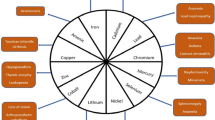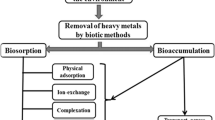Abstract
Heavy metals presence in wastewater are usually associated with the usage of metal-based chemical substances such as inorganic coagulant, metal salt, and metal-based processing. Heavy metal is defined as an essential element that can be found in Earth. Few amounts of heavy metals would be beneficial for human beings, but excessive amounts of heavy metals would become a catastrophic disaster for the environment. Therefore, it is crucial to verify the water quality, mostly when even just 1.0 mg/L of the concentration may contribute a higher impact on the environment. The existing or the remaining low concentration of heavy metals of post-chemical treatment of polluted water of wastewater remains troublesome due to incompliance effluent discharge. This chapter will highlight the removal of heavy metals through bioremediation and biotransformation. Concomitantly the mechanism and the roles of extracellular polymeric substances (EPS) will be discussed.
Access this chapter
Tax calculation will be finalised at checkout
Purchases are for personal use only
Similar content being viewed by others
References
Abdullah N, Yusof N, Lau WJ, Jaafar J, Ismail AF (2019) Recent trends of heavy metal removal from water/wastewater by membrane technologies. J Ind Eng Chem 76:17–38
Abidli A, Huang Y, Rejeb ZB, Zaoui A, Park CB (2022) Sustainable and efficient technologies for removal and recovery of toxic and valuable metals from wastewater: recent progress, challenges, and future perspectives. Chemosphere 292:133102
Akansha J, Nidheesh PV, Gopinath A, Anupama KV, Suresh Kumar M (2020) Treatment of dairy industry wastewater by combined aerated electrocoagulation and phytoremediation process. Chemosphere 253:126652
Arora PK (2020) Bacilli-mediated degradation of xenobiotic compounds and heavy metals. Front Bioeng Biotechnol 8:570307
Azimi A, Azari A, Rezakazemi M, Ansarpour M (2017) Removal of heavy metals from industrial wastewaters: a review. Chem Bio Eng Rev 4(1):37–59
Balladares E, Jerez O, Parada F, Baltierra L, Hernández C, Araneda E, Parra V (2018) Neutralization and co-precipitation of heavy metals by lime addition to effluent from acid plant in a copper smelter. Miner Eng 122(15):122–129
Barkusaraey FH, Mafigholami R, Faezi Ghasemi M, Gholam K (2021) Optimization of zinc bioleaching from paint sludge using Acidithiobacillus thiooxidans based on response surface methodology. J Environ Sci Health 56(11):1243–1252
Bernard EI, Stanley IRO, Grace OI, Ebere PA, Abraham OA, Ibe KE (2018) Toxicity and bioremediation of heavy metals contaminated ecosystem from tannery wastewater: a review. J Toxicol 2018:2568038
Birungi ZS, Shen N, Evans MNC, Roestorff M (2020) Recovery of rare earths, precious metals and bioreduction of toxic metals from wastewater using algae. In: Bharagava R (ed) Emerging eco-friendly green Technologies for Wastewater Treatment, Microorganisms for sustainability, vol 18. Springer, Singapore, pp 267–297
Bong C, Malfatti CF, Azam F, Obayashi Y, Suzuki S (2010) The effect of zinc exposure on the bacteria abundance and proteolytic activity in seawater. In: Hamamura N, Suzuki S, Mendo S, Barroso CM, Iwata H, Tanabe S (eds) Interdisciplinary studies on environmental chemistry - biological responses to contaminants. Terrapub, pp 57–63
Carolin CF, Kumar PS, Saravanan A, Joshiba GJ, Naushad M (2017) Efficient techniques for the removal of toxic heavy metals from aquatic environment: a review. J Environ Chem Eng 5(3):2782–2799
Carvajal-Fl’orez E, Santiago-Alonso CG (2019) Technologies applicable to the removal of heavy metals from landfill leachate. Environ Sci Pollut Res 26(16):15725–15753
Chang SH, Teng TT, Norli I (2010) Extraction of Cu(II) from aqueous solutions by vegetable oil-based organic solvents. J Hazard Mater 181:868–872
Chen SY, Cheng YK (2019) Effects of sulfur dosage and inoculum size on pilot-scale thermophilic bioleaching of heavy metals from sewage sludge. Chemosphere 234:346–355
Das S, Hirak RD, Jaya C (2016) Genetic basis and importance of metal resistant genes in bacteria for bioremediation of contaminated environments with toxic metal pollutants. Appl Microbiol Biotechnol 100(7):2967–2984
El Liethy MA, Mohammed AD, El-K A, Abdelaal M, Marwa Waseem AH, Elgarhy AH, Kamika I, El-S GA, Mwaheb MA (2022) Temporal phytoremediation potential for heavy metals and bacterial abundance in drainage water. Sci Rep 12:8223
Eltarahony M, Kamal A, Zaki S, Abd-El-Haleem D (2021) Heavy metals bioremediation and water softening using ureolytic strains Metschnikowia pulcherrima and Raoultella planticola. J Chem Technol Biotechnol 96(11):3152–3165
Giebner F, Kaden L, Wiche O, Tischler J, Schopf S, Schlömann M (2019) Bioleaching of cobalt from an arsenidic ore. Miner Eng 131:73–78
Gina KY, Tanga YZ, Aziz MA (2002) Derivation and application of a new model for heavy metal biosorption by algae. Water Res 36:1313–1323
Gu T, Rastegar SO, Mousavi SM, Li M, Zhou M (2018) Advances in bioleaching for recovery of metals and bioremediation of fuel ash and sewage sludge. Bioresour Technol 261:428–440
Hampu N, Werber JR, Chan WY, Feinberg EC, Hillmyer MA (2020) Next generation ultrafiltration membranes enabled by block polymers. ACS Nano 14(12):16446–16471
Hasanpour M, Hatami M (2020) Application of three-dimensional porous aerogels as adsorbent for removal of heavy metal ions from water/wastewater: a review study. Adv Colloid Interf Sci 284:102247
Iravani S, Varma RS (2020) Bacteria in heavy metal remediation and nanoparticle biosynthesis. ACS Sustain Chem Eng 8(14):5395–5409
Iravani S, Varma RS (2022) Genetically engineered organisms: possibilities and challenges of heavy metal removal and nanoparticle synthesis. Clean Technol 4:502–511
Jain R, Ashish P, Sreekrishnan TR, Dastidar MG (2010) Autoheated thermophilic aerobic sludge digestion and metal bioleaching in a two-stage reactor system. J Environ Sci 22(2):230–236
Jin Y, Luan Y, Ning Y, Wang L (2018) Effects and mechanisms of microbial remediation of heavy metals in soil: a critical review. Appl Sci 8:1336–1353
Kleinübinga SJ, Vieiraa RS, Beppua MM, Guibalb E, Carlos da Silvaa MG (2010) Characterization and evaluation of copper and nickel biosorption on acidic algae sargassum Filipendula. Mater Res 13(4):541–550
Kumar L, Bharadvaja N (2020) Microbial remediation of heavy metals. In: Shah MP (ed) Microbial bioremediation & biodegradation. Springer Singapore, Singapore, pp 49–72
Lodeiro P, Cordero B, Barriada JL, Herrero R, Sastre de Vicente ME (2002) Biosorption of cadmium by biomass of brown marine macroalgae. Bioresour Technol 96:1796–1803
Martínez EDM, Argumedo-Delira R, S’anchez-Viveros G, Alarc’on A, Mendoza-L’opez MR (2019) Microbial bioleaching of ag, au and Cu from printed circuit boards of mobile phones. Curr Microbiol 76(5):536–544
Meknasi YF, Tyagi RD, Narasiah KS (2000) Simultaneous sewage sludge digestion and metal leaching: effect of aeration. Process Biochem 36(3):263–273
Mustafa HM, Hayder G (2021) Recent studies on applications of aquatic weed plants. In phytoremediation of wastewater: a review article. Ain Shams Eng J 12(1):355–365
Pavithra KG, Kumar PS, Jaikumar V, Vardhan KH, SundarRajan P (2020) Microalgae for biofuel production and removal of heavy metals: a review. Environ Chem 18(6):1905–1923
Pohl A (2020) Removal of heavy metal ions from water and wastewaters by sulfur containing precipitation agents. Water Air Soil Pollut 231(10):503
Pushkar BK, Sevak PI, Singh A (2015) Isolation and characterization of potential microbe for bio-remediating heavy metal from Mithi river. Ann Appl BioSci 2(2):20–27
Rajadurai V, Anguraj BL (2020) Ionic liquids to remove toxic metal pollution. Environ Chem Lett 19(2):1173–1203
Ramsenthil R, Meyyappan R (2010) Single and multi-component biosorption of copper and zinc ions using microalgal resin. Int J Environ Sci Develop 1(4):298–301
Rangabhashiyam S, Balasubramanian P (2019) Characteristics, performances, equilibrium, and kinetic modeling aspects of heavy metal removal using algae. Bioresour Technol 5:261–279
Rizki IN, Tanaka ON (2019) Thiourea bioleaching for gold recycling from ewaste. Waste Manage 84:158–165
Saravanan A, Senthil Kumar P, Jeevanantham S, Karishma S, Tajsabreen B, Yaashikaa PR, Reshma B (2021) Effective water/wastewater treatment methodologies for toxic pollutants removal: processes and applications towards sustainable development. Chemosphere 280:130595
Sharma P (2021) Efficiency of bacteria and bacterial assisted phytoremediation of heavy metals: an update. Bioresour Technol 328:124835
Sheikha D, Ashour I, Abu Al-Rub FA (2008) Biosorption of zinc on immobilized green algae: equilibrium and dynamics studies. J Eng Res 5(1):20–29
Sreedevia SD, Suresh K, Guangming J (2022) Bacterial bioremediation of heavy metals in wastewater: a review of processes and applications. J Water Process Eng 48:102884
Velkova Z, Kirova G, Stoytcheva M, Kostadinova S, Todorova K, Gochev V (2018) Immobilized microbial biosorbents for heavy metals removal. Eng Life Sci 18(12):871–881
Villar LD, Garcia O Jr (2003) Assessment of anaerobic sewage sludge quality for agricultural application after metal bioleaching. Environ Technol 24(12):1553–1559
Waldman RZ, Gao F, Phillip WA, Darling SB (2021) Maximizing selectivity: an analysis of isoporous membranes. J Memb Sci 633:119389
Wong SJ, Rene ER (2017) Bioprecipitation-a promising technique for heavy metal removal and recovery from contaminated wastewater streams. MOJ Civil Engineering 2(6):191–193
Xing D, Magdouli S, Zhang J, Koubaa A (2020) Microbial remediation for the removal of inorganic contaminants from treated wood: recent trends and challenges. Chemosphere 258:127429
Yang W, Wei S, Ji L, Xiaolei Z (2020) Bioleaching of heavy metals from wastewater sludge with the aim of land application. Chemosphere 249:126134
Yavuz H, Denizli A, Güngünes H, Safarikova M, Safarik I (2006) Biosorption of mercury on magnetically modified yeast cells. Sep Purif Technol 52:253–260
Yin K, Wang Q, Lv M, Chen L (2019) Microorganism remediation strategies towards heavy metals. Chem Eng J 360:1553–1563
Yu W, Hu J, Yu Y, Ma D, Gong W, Qiu H, Hu Z, Gao HW (2021) Facile preparation of sulfonated biochar for highly efficient removal of toxic pb(II) and Cd1(II) from wastewater. Sci Total Environ 750:141545
Zhan J, Yang X, Zhang X, Wang Y, Cai X, Chen H (2021) Bioprecipitation facilitates the green synthesis of sulfidated nanoscale zero-valent iron particles for highly selective dechlorination of trichloroethene. J Environ Chem Eng 9(5):106050
Zhu Y, Fan W, Zhou T, Li X (2019) Removal of chelated heavy metals from aqueous solution: a review of current methods and mechanisms. Sci Total Environ 678:253–266
Author information
Authors and Affiliations
Corresponding author
Editor information
Editors and Affiliations
Rights and permissions
Copyright information
© 2023 The Author(s), under exclusive license to Springer Nature Singapore Pte Ltd.
About this chapter
Cite this chapter
Ismail, N., Talebi, A., Ahmad, H. (2023). Microbial Remediation of Heavy Metals. In: Singh, R.P., Singh, P., Srivastava, A. (eds) Heavy Metal Toxicity: Environmental Concerns, Remediation and Opportunities. Springer, Singapore. https://doi.org/10.1007/978-981-99-0397-9_20
Download citation
DOI: https://doi.org/10.1007/978-981-99-0397-9_20
Published:
Publisher Name: Springer, Singapore
Print ISBN: 978-981-99-0396-2
Online ISBN: 978-981-99-0397-9
eBook Packages: Earth and Environmental ScienceEarth and Environmental Science (R0)




